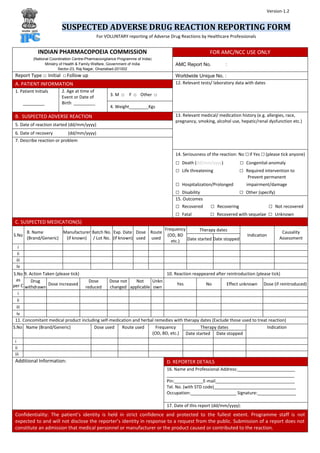
ADR Form version 1.2 2015
- 1. SUSPECTED ADVERSE DRUG REACTION REPORTING FORM For VOLUNTARY reporting of Adverse Drug Reactions by Healthcare Professionals INDIAN PHARMACOPOEIA COMMISSION (National Coordination Centre-Pharmacovigilance Programme of India) Ministry of Health & Family Welfare, Government of India Sector-23, Raj Nagar, Ghaziabad-201002 FOR AMC/NCC USE ONLY AMC Report No. : Report Type □ Initial □Follow up Worldwide Unique No. : A. PATIENT INFORMATION 12. Relevant tests/ laboratory data with dates 1. Patient Initials _________ 2. Age at time of Event or Date of Birth _________ 3. M □ F □ Other □ 4. Weight________Kgs B. SUSPECTED ADVERSE REACTION 13. Relevant medical/ medication history (e.g. allergies, race, pregnancy, smoking, alcohol use, hepatic/renal dysfunction etc.) 5. Date of reaction started (dd/mm/yyyy) 6. Date of recovery (dd/mm/yyyy) 7. Describe reaction or problem 14. Seriousness of the reaction: No □if Yes □(please tick anyone) □ Death (dd/mm/yyyy) □ Congenital-anomaly □ Life threatening □ Required intervention to Prevent permanent □ Hospitalization/Prolonged impairment/damage □ Disability □ Other (specify) 15. Outcomes □ Recovered □ Recovering □ Not recovered □ Fatal □ Recovered with sequelae □ Unknown C. SUSPECTED MEDICATION(S) S.No 8. Name (Brand/Generic) Manufacturer (if known) Batch No. / Lot No. Exp. Date (if known) Dose used Route used Frequency (OD, BD etc.) Therapy dates Indication Causality AssessmentDate started Date stopped i ii iii Iv S.No as per C 9. Action Taken (please tick) 10. Reaction reappeared after reintroduction (please tick) Drug withdrawn Dose increased Dose reduced Dose not changed Not applicable Unkn own Yes No Effect unknown Dose (if reintroduced) i ii iii iv 11. Concomitant medical product including self-medication and herbal remedies with therapy dates (Exclude those used to treat reaction) S.No Name (Brand/Generic) Dose used Route used Frequency (OD, BD, etc.) Therapy dates Indication Date started Date stopped i ii iii Additional Information: D. REPORTER DETAILS 16. Name and Professional Address:________________________ _____________________________________________________ Pin:____________E-mail_________________________________ Tel. No. (with STD code)__________________________________ Occupation:___________________ Signature:________________ 17. Date of this report (dd/mm/yyyy): Confidentiality: The patient’s identity is held in strict confidence and protected to the fullest extent. Programme staff is not expected to and will not disclose the reporter’s identity in response to a request from the public. Submission of a report does not constitute an admission that medical personnel or manufacturer or the product caused or contributed to the reaction. Version-1.2
- 2. ADVICE ABOUT REPORTING A. What to report Report serious adverse drug reactions. A reaction is serious when the patient outcome is: Death Life-threatening Hospitalization (initial or prolonged) Disability (significant, persistent or permanent) Congenital anomaly Required intervention to prevent permanent impairment or damage Report non-serious, known or unknown, frequent or rare adverse drug reactions due to Medicines, Vaccines and Herbal products. B. Who can report All healthcare professionals (Clinicians, Dentists, Pharmacists and Nurses) can report adverse drug reactions C. Where to report Duly filled Suspected Adverse Drug Reaction Reporting Form can be send to the nearest Adverse Drug Reaction Monitoring Centre (AMC) or directly to the National Coordination Centre (NCC). Call on Helpline (Toll Free) 1800 180 3024 to report ADRs. Or can directly mail this filled form to pvpi@ipcindia.net or pvpi.ipcindia@gmail.com A list of nationwide AMCs is available at: http://www.ipc.gov.in, http://www.ipc.gov.in/PvPI/pv_home.html D. What happens to the submitted information Information provided in this form is handled in strict confidence. The causality assessment is carried out at AMCs by using WHO-UMC scale. The analyzed forms are forwarded to the NCC through ADR database. Finally the data is analyzed and forwarded to the Global Pharmacovigilance Database managed by WHO Uppsala Monitoring Centre in Sweden. The reports are periodically reviewed by the NCC-PvPI. The information generated on the basis of these reports helps in continuous assessment of the benefit-risk ratio of medicines. The information is submitted to the Steering committee of PvPI constituted by the Ministry of Health & Family Welfare. The Committee is entrusted with the responsibility to review the data and suggest any interventions that may be required. E. Mandatory field for suspected ADR reporting form Patient initials, age at onset of reaction, reaction term(s), date of onset of reaction, suspected medication(s) and reporter information. National Coordination Centre Pharmacovigilance Programme of India Ministry of Health & Family Welfare, Government of India Sector-23, Raj Nagar, Ghaziabad-201002 Tel.: 0120-2783400, 2783401, 2783392 Fax: 0120-2783311 www.ipc.nic.in Pharmacovigilance Programme of India for Assuring Drug Safety For ADRs Reporting Call on PvPI Helpline (Toll Free) 1800 180 3024 (9:00 AM to 5:30 PM, Working Days)
